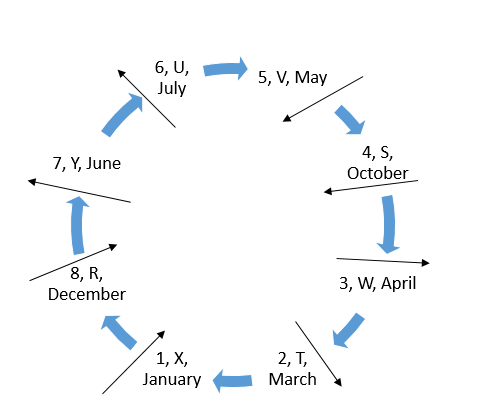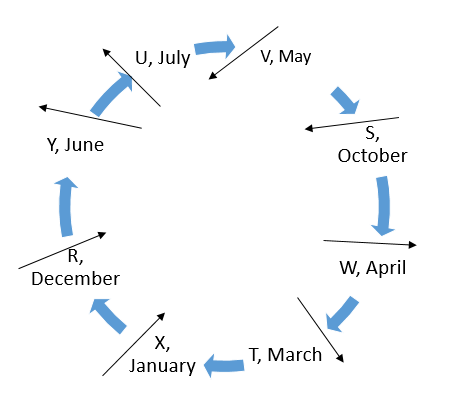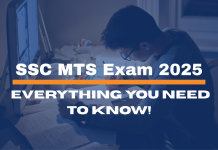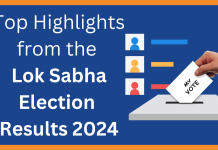The Reasoning section is a crucial component in bank exams, carrying significant weightage, and mastering it is essential for achieving high scores. To aid your preparation, we present a set of moderate-level Reasoning Quiz questions, focusing on Linear and Seating Arrangement puzzles. These questions are relevant for upcoming Prelims exams such as SBI Clerk, RBI Assistant, and NABARD Grade A. Linear and Seating Arrangement puzzles are common in banking exams, testing candidates’ logical reasoning and analytical skills. It is recommended to set a timer for 10 minutes when attempting these questions, simulating exam conditions to enhance time management skills.
By practicing these puzzles, you can refine your ability to quickly decipher and solve complex arrangements, a key skill in the competitive banking exams. As time management is critical during the actual exam, regular practice with timed quizzes can significantly boost your confidence and performance. Make the most of this opportunity to strengthen your Reasoning skills, and remember to review your solutions to identify areas for improvement. Consistent and focused practice on such puzzles will undoubtedly contribute to your success in the upcoming bank exams.

Prepping for NABARD Grade A, SBI Clerk, RBI Assistant with ixamBee
Embarking on the journey to crack competitive exams like NABARD Grade A, SBI Clerk, and RBI Assistant requires a strategic and comprehensive approach, and ixamBee is a valuable companion in this endeavor. Recognized for its commitment to quality education and exam-oriented content, ixamBee offers a range of resources tailored for aspirants aiming to excel in NABARD Grade A, SBI Clerk, and RBI Assistant Exams. One of the key strengths of ixamBee is its extensive collection of mock tests designed specifically for NABARD Grade A, SBI Clerk, and RBI Assistant. These mock tests simulate the actual exam environment, enabling candidates to gauge their preparedness and identify areas for improvement. The platform also provides detailed performance analytics to help aspirants track their progress systematically.
In addition to mock tests, ixamBee offers comprehensive online courses for NABARD Grade A, SBI Clerk, and RBI Assistant. These courses are crafted by experienced faculty members, covering the entire syllabus in a structured manner. The interactive nature of these courses facilitates better understanding and retention of concepts. ixamBee understands the significance of practicing with authentic exam material. Hence, it provides access to NABARD Grade A, SBI Clerk, and RBI Assistant Previous Year Papers. Solving these papers gives aspirants insights into the exam pattern, question types, and helps build confidence for the actual exam day.
ixamBee has emerged as a holistic platform for aspirants gearing up for NABARD Grade A, SBI Clerk, and RBI Assistant Exams, offering a diverse set of resources including mock tests, online courses, and previous year papers. With ixamBee, candidates can enhance their preparation and boost their chances of success in these highly competitive exams.
Sample Reasoning Questions for NABARD Grade A, SBI Clerk, and RBI Assistant Exams
Directions (1-5): Read the given information carefully and answer the given questions.
Eight friends are sitting in a straight line. Some of them face north while some of them face south direction. All of them were born in different months starting from January to August of the same year and on same date.
(i) C who sits at the extreme end of the row and faces south. H is not an immediate neighbour of the oldest person and faces opposite to F and C. Only three persons sit between C and G who was born in June.
(ii) E is not an immediate neighbour of G and sits second to the right of B. D sits second to the right of A who is the oldest person in the group. H is the third oldest person in the group.
(iii) A is not an immediate neighbour of C and G. F was born in May and sits fourth to the left of the one who was born in March. E faces same direction as F but opposite to B and D.
(iv) C is four months older than B. Second oldest person sits immediate right of the one who is third youngest.
1. Who among the following second youngest person in the group?
(a) D
(b) H
(c) V
(d) E
(e) None of these
Q2. Who among the following sits third to the right of D?
(a) B
(b) H
(c) F
(d) A
(e) None of these
Q3. D was born in which of the following month?
(a) February
(b) January
(c) March
(d) August
(e) None of these
Q4. Which of the following statement is not true about G?
(a) G sits third to the right of the one who was born in January
(b) G was born in March
(c) H sits second to the left of G
(d) G is facing south
(e) None is true
Q5. How many persons sit between C and F?
(a) One
(b) Two
(c) Three
(d) More than four
(e) None
Direction (6-10): Study following information carefully and answer the questions given below.
Eight friends- R, S, T, U, V, W, X and Y are sitting around a circular table. Some of them are facing center and some of them facing outward. Each of them was born in different months, viz. January, March, April, May, June, July, October and December, but not necessarily in the same order.
(i)X was born in the month of January and facing center. Only three persons sit between X and V. T sits second to the left of S but not an immediate neighbour of V. T and U are facing same directions.
(ii) The one who was born in the month of December is not an immediate neighbour of W. The one who was born in the month of March sits third to the left of the one who was born in the month of May. The one who was born in the month of December sits second to the left of U. Only three persons sit between the one who was born in the month of April and the one who was born in the month of June and both are facing same direction.
(iii) Y and R are immediate neighbours both are facing opposite directions. Only three persons sit between T and U. W and Y are facing same direction. The one who was born in the month of June and the one who was born in the month of March are not immediate neighbours.
(iv) The one who was born in the month of October sits third to the right of the one who was born in the month of June. S is an immediate neighbour of V. The immediate neighbours of X facing opposite directions.
(v) The one who was born in the month of May facing center of the table. Only two persons sit between V and the one who was born in the month of March. Y is not an immediate neighbour of X.
6. Which of the following combinations is correct?
a) W – June
b) Y – April
c) U – May
d) V – July
e) None of these
7. How many persons sit between the one who was born in the month of January and the one who was born in the month of May?
a) One
b) Two
c) Three
d) No one
e) None of these
8. Four of the following five are alike in certain way and thus form a group as per the given arrangement. Which of the following does not belong to that group?
a) June
b) April
c) July
d) October
e) March
9. Who among the following was born in the month of October?
a) W
b) U
c) T
d) S
e) None of these
10. What is the position of T with respect to the one who was born in the month of December?
a) Second to the right
b) Second to the left
c) Immediate right
d) Immediate left
e) None of these
Solutions:
Ans(1-5):
1-(d), 2:-(b), 3:-(a), 4:-(b), 5:-(d)
From (i), we will have two cases:
Case 1.
C will sit at place no. 1. G will sit at place no. 5.
From (ii), we will two subcases:
If B faces south and sits at place no. 4, then E will sit at place no.2.
This case will get discarded as there is no place left for A.

If B faces north and sits at place no. 6, then E will sit at place no.8.
A will sit at place no. 2 and faces north. D will sit at place no. 4.
From (i), H cannot sit at place no. 3 as he is not an immediate neighbour of the oldest person. So, H will sit at place no. 7.
Only person left for place no. 3 is F and faces north.
From (iii), F was born in May and sits fourth to the left of the one who was born in March. It means H born in the month of March.
This case will get discarded as F faces same direction as B.

Case 1.b.
Case 2.
C will sit at place no. 8. G will sit at place no. 4.
From (ii), we will two subcases:
If B faces south and sits at place no. 3, then E will sit at place no.1.
A will sit at place no. 7 and faces south. D will sit at place no. 5.
From (i), H cannot sit at place no. 3 as he is not an immediate neighbour of the oldest person. So, H will sit at place no. 2.
Only person left for place no. 6 is F and faces south.
This case will get discarded H faces north.

If B faces north and sits at place no. 5, then E will sit at place no.7.
A will sit at place no. 1 and faces north. D will sit at place no. 3.
From (i), H cannot sit at place no. 3 as he is not an immediate neighbour of the oldest person. So, H will sit at place no. 6.
Only person left for place no. 2 is F and faces south.
From (iii), F was born in May and sits fourth to the left of the one who was born in March. It means H born in the month of March.
E will face same direction as F. B and D will same direction.
From (iv) C is four months older than B. It means C born in April and B born in August.

Final arrangement as shown below:

Ans (6-10):
6:-(e), 7:-(c), 8:-(d), 9:-(d), 10:-(a) .
From (i), If X sits at place no. 1, then V will sit at place no. 5.
From (ii) and (iv), S sits at place no. 6 and faces the centre, then T will sit at place no. 2.
From (iii) and (v), U will sit at place no. 6. We need two consecutive places for Y and R. So, two places left for Y and R are 7 and 8. Y cannot sit at place no. 8 as he is not an immediate neighbour of X.
Only person left for place no. 3 is W.

From (ii),If U faces the centre, then the one who was born in the month of December sits at place no. 4 but it is not possible as the one who was born in the month of December is not an immediate neighbour of V. So, U faces outside the centre and the one who was born in the month of December sits at place no.8.
From (v), The one who was born in the month of March sits at place no. 2.
From (i), T and U are facing same direction.
From (iv), R faces the centre.
From (ii) and (v), The one who was born in the month of May sits at place no. 5 and faces the centre.
From (ii), the one who was born in the month of April and the one who was born in the month of June sits at place no. 7 and 3 respectively.
From (iv), the one who was born in the month of June faces outside the centre and the one who was born in the month of October sits at place no. 4.
From (iii), W and Y are facing same direction.
Only month left for U is July.

Final arrangement as shown below:

Summing Up
Mastering the Reasoning section is pivotal for success in NABARD Grade A, SBI Clerk, and RBI Assistant exams. The provided set of moderate-level Reasoning Quiz questions, particularly focusing on Linear and Seating Arrangement puzzles, serves as a valuable practice resource. Additionally, ixamBee’s comprehensive offerings, including mock tests, online courses, and previous year papers, position it as an indispensable companion for aspirants, fostering a well-rounded preparation strategy and increasing the likelihood of success in these competitive exams.
To help you prepare 50% faster for competitive exams, ixamBee provides a free Mock Test Series and all the Current Affairs in English and Current Affairs in Hindi in the BeePedia capsules for GA Preparation. You can also get the latest updates for Bank PO, Bank Clerk, SSC, RBI Grade B, NABARD, and Other Government Jobs.
Also Read
How to Decide Which Government Exam You Should Prepare For?
How Many Types of Government Job Exams are There?
NABARD Grade A 2024: Decision Making Syllabus and Preparation
















